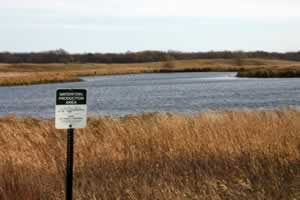The Small Wetlands Program:
|
 |
| Credit: USFWS |
| Waterfowl Protection Area |
The U.S. Fish and Wildlife Service’s Small Wetlands Program was created to stem the rapid loss of important small wetlands and grassland habitat across the Prairie Pothole Region of the U.S. In its half-century of existence, the Small Wetlands Program has become one of the most successful landscape-level conservation efforts in the nation, complementing the success of the Federal Duck Stamp Program.
The Small Wetlands Program began in 1958 as an amendment to the Migratory Bird Hunting Stamp Act of 1934 (also known as the Duck Stamp Act). It authorized the Service to use Duck Stamp funds to acquire Waterfowl Production Areas, small wetland and pothole areas and interests managed by the National Wildlife Refuge System for the benefit of migratory waterfowl. Since then, the Service has permanently protected nearly 3 million acres of prairie habitat.
The wetlands and virgin grasslands in this glacially-created landscape are among the most endangered habitats in the country. While the region accounts for just 10 percent of North American waterfowl breeding habitat, it produces nearly half the continent’s total ducks. These lands also help connect people with nature by offering excellent places for bird watching, hunting, photography, and environmental education.
The Service is celebrating the Small Wetlands Program this year by highlighting its successful past and the need to continue conserving this resource for future generations.What can you do? Buy a Federal Duck Stamp. And more importantly, tell people how important Federal Duck Stamps are to ensuring healthy populations of all migratory birds.

